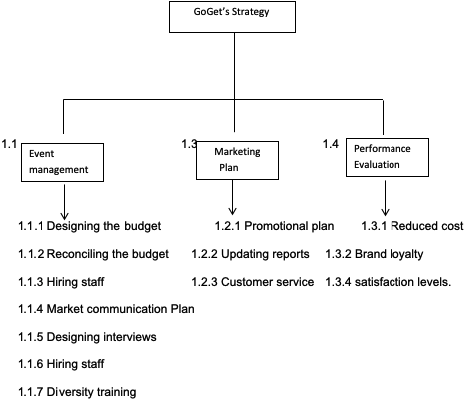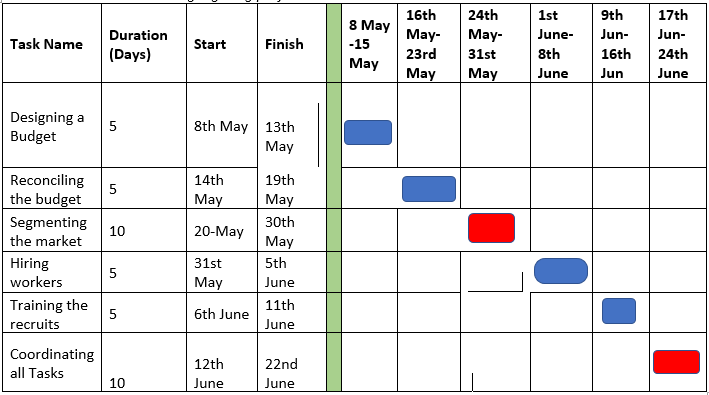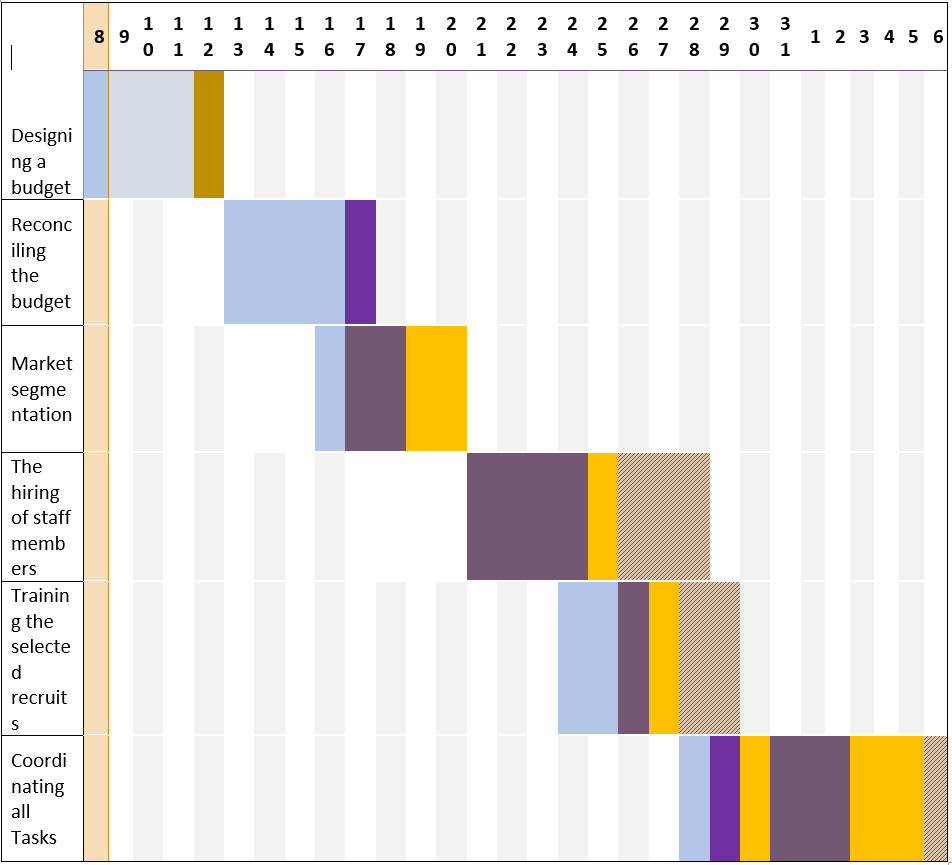Introduction
Overview of the GoGet Company
GoGet is an Australian car rental company that was founded in June 2003 by Bruce Jeffreys, Nick Lowe, and ten other members. Since then, the GoGet Company has undergone major developments. This is confirmed by the fact that it has managed to increase its business size from 3 cars to over 1700 cars (GoGet, Ltd., 2015).
With its headquarters in Sydney, the GoGet Company targets clients from diverse parts of Australia, including Sydney, Brisbane, Adelaide, and Melbourne. Its vehicles vary from the latest models to station wagons. These vehicles are managed properly, as confirmed by a private location for each vehicle. The reservation of each car is normally made through telephone or through the company’s website. The company’s slogan, ‘why get a car when you can GoGet,’ has been used a marketing strategy for increasing the sales volume of the organisation (GoGet, Ltd., 2015).
Background
The car rental industry in Australia continues to show prospects in growth capabilities. This is confirmed by a growth of 10% in value by the end of 2013(Prideaux & Carson 2010, p. 167). This growth rate stems from the fact that Australia is basically perceived as a safe country. This state of affairs creates an avenue for increased numbers of tourists within the region.
Additionally, the high growth rate of car rental business is attributed to the fact that Australia has limited alternatives in the transport sector, especially in the railway infrastructure. But despite the presence of this opportunity, the car rental industry is faced with diverse challenges, which adversely affect the strategy of the GoGet Company in a number of ways. First, the GoGet Company has to ensure that it consistently upgrades its cars in order to remain competitive in the market (Prideaux & Carson 2010, p. 168).
This necessitates a high capital investment. Second, the GoGet Company is required to adopt the current technology trend in the market consistently, including heavy investment in the software. This requirement has necessitated the need for high levels of capital investment for the GoGet Company. It is for this reason that the GoGet Company seeks to venture in the Singapore market.
Given the increased expenses of owning a car in Singapore, It is on record that the demand for car rental services is on an upward trend. According to Prideaux and Carson (2010, p. 168), the number of rental cars has increased from 12391 to 16,396 from 2008 to 2013. This is partly attributed to the requirement for subscribing to the Certificate of Entitlement (COE) system, which is considered expensive by the vast majority of the local people. Moreover, the tourism industry has been on an upward trend since 2008. This state of affairs has created a demand for rental cars for the locals market. It is from this perspective that GoGet considers Singapore market as an attractive overseas market.
Purpose and Objectives
This project purposes of acquiring economies of scale in the Singapore market. This will necessitate adopting the following objectives:
- To reduce the operation cost $ 200,000 per annum;
- To increase net profit margin by 35 % within the first four years of operation in the Singapore market; and
- To create extensive brand loyalty for the GoGet Company by 2017.
Thus, the entry of the GoGet Company into the Singapore market will necessitate a number of tasks. These tasks include the following:
- Setting up a reliable customer service base that will help ensure customer loyalty;
- Communicating in a manner that would motivate the workers toward accepting the project; and
- Promoting GoGet services to stakeholders in a manner that will help them believe that hiring a GoGet car is a better option.
RACI Chart
The GoGet Company will develop an HR management system that will take into account the need for accountability. This will be accomplished through a RACI chart. According to Melton (2011, p. 103), a RACI chart can be defined as a tool that highlights all the responsibilities intended to be undertaken by the members of a project against the most responsible persons.
However, given the need for teamwork in project management, the chart highlights the role of the team members by specifying the most responsible person, the accountable person, the person to be consulted, and the person to be informed about every activity. In order to have a comprehensive overview of these tasks, the GoGet Company will develop a RACI chart using titles, as illustrated in Table 1 below
Table 1: RACI chart.
R = Responsible, A=Accountable/ Approval/ Answerable, C= Consulted, I= Informed
Work Breakdown Structure
A work breakdown structure can be defined as a project management tool that collapses all the project tasks in a manner that facilitates the realisation of the objectives of the project (Norman, Brotherton, & Fried 2010). The design of the work breakdown structure, which is usually in a hierarchical manner, facilitates clarity of the deliverables. Thus, the overall objective of this work breakdown structure is providing the schedule in details, as illustrated in figure 1 below. A work breakdown structure is a viable project management tool since it facilitates the estimation of cost (Norman, Brotherton, & Fried 2010).

Schedule
Activity on Node (AON) Network Diagram
To achieve the objectives of a project calls for the need to establish how project elements relate to each other. This is normally achieved through the Activity on Node (AON) Network Diagram. According to Nicholas and Steyn (2008, p. 197), the AoN network diagram can be described as a flow chart that highlights how the project elements interrelate to achieve the objectives of the project.
Using the network diagram, an organisation is able to establish the extent to which one activity affects the success of the other, as illustrated in the diagram below. Thus, the diagram takes into account the need to analyse and organize the elements in a manner that arranges project tasks in a sequence. Additionally, the network diagram highlights the amount of time it takes to complete each project element, as illustrated in figure 2 below.

Resource Loading
The type of the project at hand normally determines the resource required to complete the tasks. Thus, the selected resources need to be closely related to the project at hand. Allocation of resources starts by defining the resource requirements and the time for completion. In this regard, the GoGet Company will seek to match the available resources with individual skills and working hours required, as illustrated in Table 2 below. Moreover, the resource loading will seek to identify the gaps within the resource allocation, including over allocation and under allocation of duties. According to Ruhe and Wohlin (2014, p. 75), allocation of duties is one of the gaps that arise in project management, as confirmed by over allocation and under allocation of duties and responsibilities within projects. Thus, resource loading will be adopted to prevent negative implications on the success of the project.
Table 2: Resource Loading.
Gantt chart
A Gantt chart is a project management tool that is used to highlight the project tasks against the time. This is achieved by highlighting each activity using a bar. While the position of the bar represents the date, the length of the bar represents duration, as illustrated in table 3 below. Hence, the Gantt chart is critical since it helps the project team to identify not only the duration of the project but also establishing the presence of overlap between project tasks.

Budget
Incentives for the Personnel
Relationship with the deliverables and cash flow
Since the aim of this project is to reduce operation cost, the GoGet Company will only provide small amounts of incentives to motivate the personnel. And since the project manager is responsible for ensuring the success of the project, providing him with an incentive of 20% is justifiable. Thus, the project manager will be responsible for the success of the plan, as he will seek to ensure that he controls all the project tasks.
Workers’ Benefits
Relationship with the deliverables and cash flow
Despite the fact that reducing cost is one of the deliverables of this project, the GoGet Company will introduce limited incentives to the workers. This is critical since it will ensure a smooth transition into the Singapore market, as well as increased levels of job morale. Moreover, this will help create an extensive brand loyalty of the GoGet Company by 2017
Feasibility Study
Relationship with the deliverables
In order for the GoGet Company to excel in cost reduction and attain brand loyalty by 2017, it is required to evaluate the feasibility of the market, including consumer behaviour, market trend, and competitors’ analysis, among other factors related to car rental industry.
Administrative Expenses
Relationship with the deliverables and cash flow
In a bid to reduce the cost of operation, the GoGet Company will purchase quality administrative tools, which will reduce the cost of maintenance. It is for this reason that the company will purchase quality laptops and a projector, which will be used to inform the stakeholders about the proceedings of the project through presentations.
Staff Cost
Relationship with the deliverables and Cashflow
Despite the need to reduce the cost of operation in the Singapore market, the GoGet Company will provide training programs to the workers, but at a considerable cost. This is critical since it will create an avenue for business-customer relation and hence increase brand loyalty. Moreover, the cost of hiring a marketing coordinator does not supersede the benefits of business-customer relations.
Other Expenses
Relationship with the deliverables and Cashflow
Given the fact that reduction of cost in the Singapore market is at the heart of the GoGet Company, the company will seek to break down the cost of land lease, brochures, and telephone cost in order to establish the cost per unit. This will facilitate the management of cost.
Budget Summary and Grand Total
Change Management
It is imperative to mention that projects are faced with diverse challenges. These challenges mainly stem from time and financial constraints, as well as the uncertainty of the prevailing market trend. The presence of uncertainties necessitates the need for adopting alternatives within the project management plan. One of the techniques adopted by most project managers includes project crashing.
According to Pries and Quigley (2008, p.116), project crashing can be explained as the process that seeks to accelerate project tasks in a manner that facilitate achievement of deliverables as expected. This state of affairs emanates from an unrealistic schedule of the initial plan, changes in the market trend, the presence of laxity in implementation, and the presence of unexpected risks.
For case in point, after the GoGet Company entered into the Singapore market, the project donors requested for the additional commitment of resources. This request was mand after the donors established that the GoGet Company was bound to face unexpected risks in the market. As such, the donors demanded a feasibility study. This study subsequently influenced the budget and the schedule of the project. Managing such kind of change calls for a critical evaluation that helps an organization to link its strategy with the project’s deliverables. Firstly, the project manager should seek to ensure that he/she aligns change management with the project deliverable.
This approach is critical since it helps the project to counter the discrepancies within the change process. Secondly, the project manager should seek to establish the degree to which the proposed change(s) can be adopted without adversely affecting the initial budget. This can be established through resource-levelling. According to Harris and Eastwood Harris Pty Ltd. (2010), resource levelling can be explained as a tool that facilitates the unbalanced allocation of project resources. This can be achieved through two major strategies: finishing a project within the specified time and finishing the proposed project using the readily available capital resources.
For case in point, the GoGet Company was able to make a trade-off between the cost of personnel incentives and the cost of a feasibility study in order to comply with the proposed changes. As such, the incentives for the functional manager and the project coordinator were reduced to 10% of the annual salary.
Moreover, the GoGet Company was able to clarify the need for changes to the project team, employees, and all the other stakeholders of the company. This entailed providing a detailed report of the challenges facing the GoGet Company in the car rental industry as it seeks to venture in the Singapore market. Thus, clear clarification of the increased operational cost of running a rental car business in Singapore was outlined.
It is from this background that the GoGet Company highlighted the need to acquire economies of scale in the Singapore market by reducing the operation cost to $ 200,000 per annum; increasing the net profit by a margin of 35 % within the first four years of operation in the Singapore market, and creating an extensive brand loyalty of the GoGet cars by 2017. Moreover, the GoGet Company took the responsibility of informing the stakeholders the need for adopting cost-effective measures.
After clarifying the need for change, the GoGet Company provided a detailed report of how the change process will be handled. As such, the need for completing the project tasks using the available resources was taken into account. But given the fact that increasing the number of resources is one of the major factors required to manage change, the GoGet Company was able to establish the need for increasing the resources in order to facilitate a pilot study. This entailed working for extra hours and increasing the number of stakeholders. Thus, the project considered the change process from the perspective of both the workers and the external stakeholders. While the workers addressed changes by voicing their opinions with respect to the change process, the external stakeholders acted as change agents by providing the company with information concerning adaptation to the Singapore market.
Progress Reporting
Despite the fact that the project plan is set up in a professional manner, it is critical to establish the validity of the plan through progress reporting. Thus, it is crucial to note that the project may be faced with unprecedented risk emanating from changes in social, political, cultural, and environmental factors. It is for this reason that the project has highlighted diverse discrepancies in budget planning and implementation. This is consistent with Doraiswamy and Shiv (2012) findings, which highlight financial constrains as one of the challenges facing project management. This state of affairs calls for adaptive strategy, which demands adaption to the market rather than making progress based on the proposed project plan.

Updated Communication Plan
Communication plan is considered critical in ensuring the success of the project. This entails outlining the person(s) that should be notified in case of any discrepancy within the project plans, as well as addressing the manner in which issues should be communicated. The communication plan of the GoGet Company was defined after an evaluation of some factors, including communication objectives and stakeholder analysis. As such, the GoGet Company has managed to adopt a number of communication documents from the beginning to the end of the project. These documents include project wikis, project status report, risk and change management plan, and closing report.
Conclusion
This report begins by introducing the GoGet Company through its profile. Consequently, the report has provided the background of the report and the importance/objectives of the project. Through a RACI chart, the report has managed to outline accountability of the personnel in a manner that articulates the roles and responsibility of each member of the team. Moreover, a number of project management tools have effectively addressed the project tasks in a number of areas, including cost and schedule, among others.
These tools include work breakdown structure, network diagram, resource loading, and Gantt chart, among others. Moreover, the report has highlighted how the GoGet Company is well prepared in the management of changes by adopting the project crashing technique and resource-levelling. Finally, this report provides a viable way of evaluating the project through progress reporting and updated communication plan.
Reference List
Doraiswamy, P & Shiv, P 2012, 50 top IT project management challenges, IT Governance Publishers, Ely, Cambridgeshire. Web.
GoGet, Ltd. 2015, We use GoGet instead of having our own car. Web.
Harris, P & Eastwood Harris Pty Ltd. 2010, Project planning and control using Primavera P6: For all industries including version 4 to 7: planning and progressing project schedules with and without roles and resources in an established enterprise environment, Eastwood Harris, Doncaster Heights, Vic. Web.
Melton, T 2011, Project management toolkit: The basics for project success: expert skills for success in engineering, technical, process industry and corporate projects, Butterworth-Heinemann, Oxford. Web.
Nicholas, J & Steyn, H 2008, Project management for business, engineering, and technology: Principles and practice, Elsevier Butterworth Heinemann, Amsterdam. Web.
Norman, E, Brotherton, A, & Fried, R 2010, Work breakdown structures: The foundation for project management excellence, John Wiley & Sons, Hoboken, N.J. Web.
Prideaux, B & Carson, D 2010, Drive tourism: Trends and emerging markets, Routledge, London. Web.
Pries, K & Quigley, J 2008, Project management of complex and embedded systems: Ensuring product integrity and program quality, CRC Press, Boca Raton. Web.
Ruhe, G & Wohlin, C 2014, Software project management in a changing world, Springer, New York. Web.